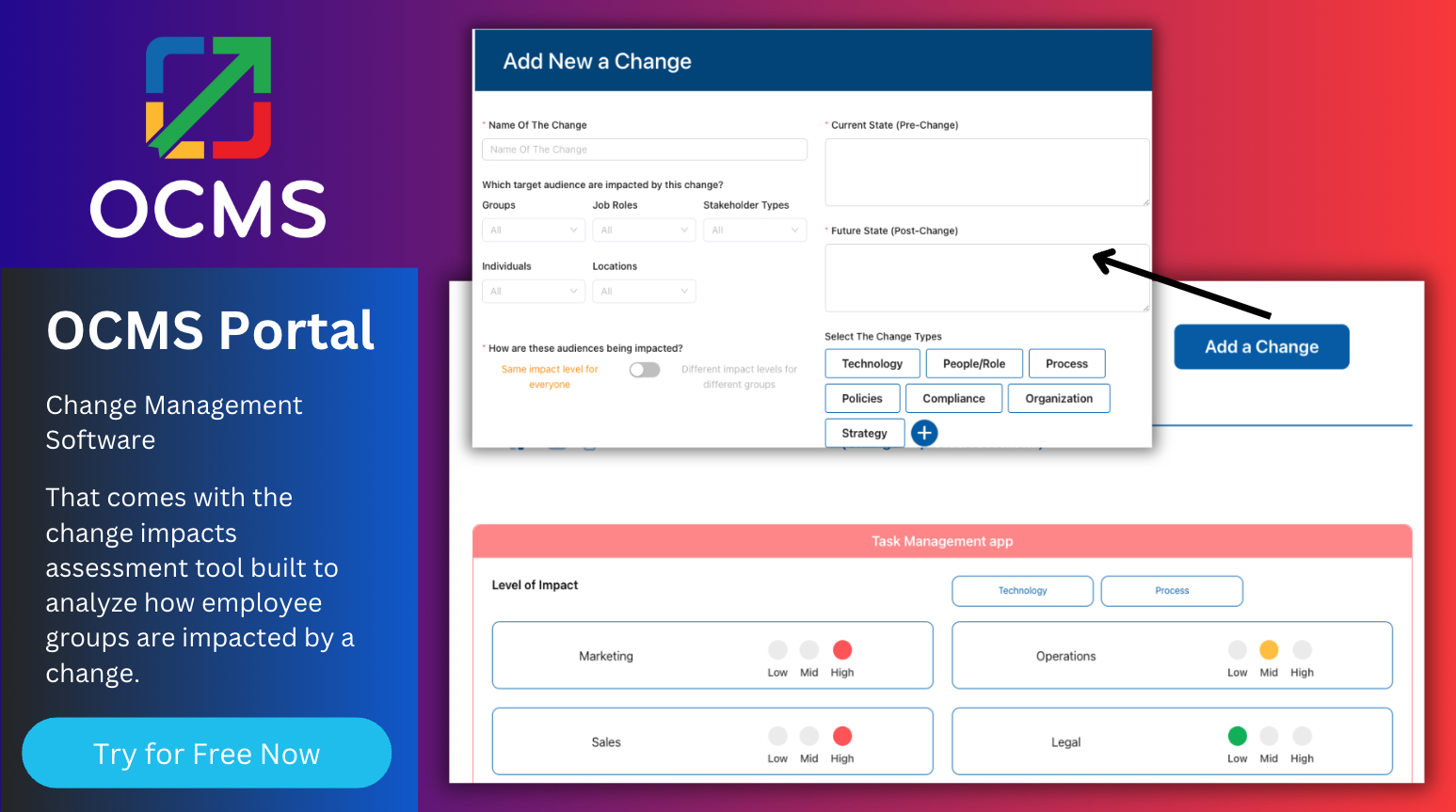The Ultimate Guide to Change Impact Assessments with Templates
2024 Step-by-Step Guide for Change Management & Project Managers
 Welcome to Your Guide for a Smooth Change Journey!
Welcome to Your Guide for a Smooth Change Journey!
Change is an inevitable part of life, and in the dynamic world of business, it’s a constant companion. Whether you’re a change management professional or a dedicated team member ready to embrace transformation, understanding the impact of change on impacted groups and individuals is your golden ticket to success.
That’s where this business change impact analysis guide comes in – your trusty companion for the change journey! We’re here to demystify the art of the high level change impact assessment, making it accessible, comprehensive, and, dare we say, fun.
Change doesn’t have to be a bumpy ride; with the right knowledge and tools, you can steer your organization toward success and ensure a smoother transition for everyone involved.
Picture this guide as your friendly GPS for the winding roads of organizational change. We’ll help you navigate the twists and turns, steering clear of bumps and roadblocks. Together, we’ll explore the why, what, and how of Change Impact Assessment, ensuring your projects not only survive but thrive.
So, fasten your seatbelts and join us on this adventure through the world of Change Impact Assessment.
Looking for a concise summary? It’s just below. But if you’re itching for a deeper dive and want answers to questions like “what is the change impact definition” or “how to conduct a change impact assessment”, stay tuned as we answer all of that and more in the reading materials ahead.
Quick Summary
The Basics of Organizational Change Impact Analysis
A change impact analysis assesses how organizational changes will affect people, processes, and systems. It evaluates the impact of changes on individuals, groups, and various operational aspects during transformations like process changes, culture shifts, technology upgrades, or expansion.
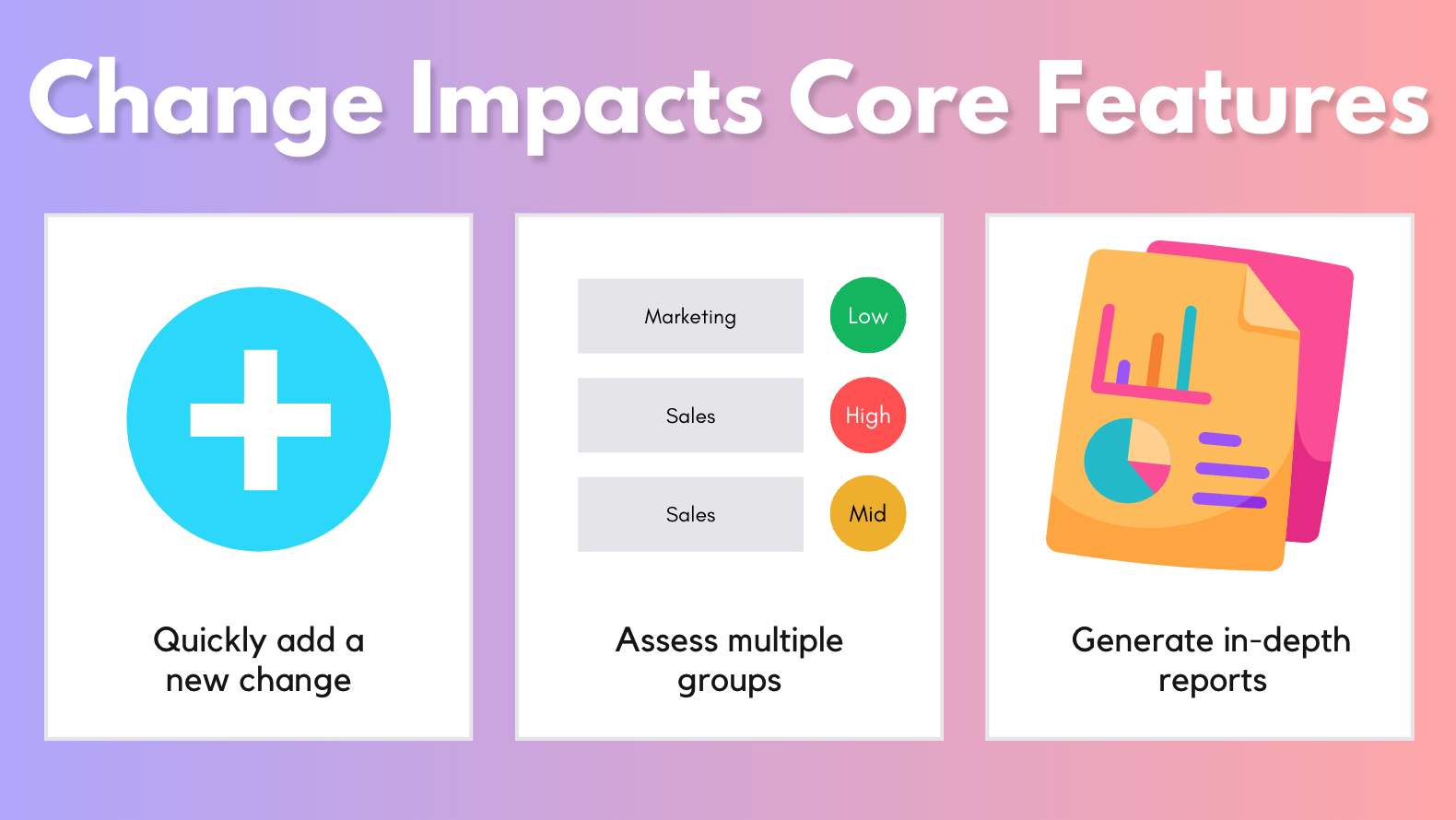
Feeling the headache of juggling those complex and fragmented change impacts assessments in Excel? Well, it’s time to embrace new change with OCMS Portal, your ultimate change management solution for successful transformation. This magic box comes equipped with the Change Impacts Assessment Tool, making impact analysis a breeze, and a whole lot more to ensure your change management venture thrives. Best part? It’s a free sign-up today, and guess what – no credit card needed! Let’s get started!
Internal and External Impact Analysis: Is it Necessary?
Assessing both internal and external groups is crucial for effective impact analysis in change management. This involves evaluating how organizational changes will affect not only internal audiences but also external parties like customers, vendors, and affiliates.
Understanding who will be impacted, the nature and severity of the impact is essential for successful implementation of change projects.
Three key types of impact assessments are mentioned:
- Business Change Impact Analysis: Identifies internal groups, departments, functions, teams, and job roles impacted by organizational changes including M&A, transformation, reorganization, enterprise-wide implementations, and more.
- System Impact Assessment: Focuses on business processes and legacy technology tools affected or replaced by technological changes.
- Organizational Culture and Operational Change Impact Analysis: Identifies the groups and individuals affected by shifts in culture, mindset, or operations and determines the necessary support.
The definition of impact analysis can vary between organizations, but it generally includes attributes like changes in job roles, duties, processes, software, equipment, culture, structure, policies, products, and any other alterations that require adopting new practices by employees or external groups (such as vendors and customers). Assessing and managing these impacts is essential for project success in change management.
Realizing the Benefits of the Change Impact Analysis in Project Management
Incorporating change management, including a change impact assessment report and process, into a project is vital to its success. Projects often fail when people who need to adapt to new changes in their daily workflow aren’t adequately prepared. For instance, implementing new CRM software without effective change management can lead to users feeling uncertain, dissatisfied with the software, or unsure how to use it, resulting in a failed project.
Change management for a project involves understanding the impact of change on the organization through stakeholder and customer impact assessments. This information guides the change management team in engaging stakeholders to ensure a smooth transition and familiarity with the new change. Stakeholders can be engaged through:
- Communication
- Engagement
- Training
- Briefings and Meetings
- Coaching
- and More
Empowering Change Managers with Impact Assessment Frameworks.
Conducting an effective impact assessment for changes to people, processes, tools, M&A, software, systems, and solutions requires clear and concise steps.
Using an industry-standard change impact analysis framework places you on the path to success. The framework includes two questionnaires, one for the current state (As-Is Assessment) and one for the future state (To-Be Assessment). These questionnaires help in identifying:
- Processes that will be discontinued.
- Users of processes being phased out.
- Effort required for the transition.
- Adjustments needed in system interfaces.
- Groups and roles affected by interface changes.
- New processes to be introduced in the future state.
- Users of these new processes.
- Effort required for the adoption of new processes.
- New system interfaces introduced in the future state.
- Groups and roles impacted by these new interfaces.
- Changes in job roles and tasks after the transition.
- The effort needed to transition impacted individuals from the current to the future state.
- This framework provides a structured approach to assess and manage the impact of changes during a project or organizational transition.
The OCMS Portal organizational change management software includes the Change Impacts Assessment tool designed to analyze how employee groups will be uniquely impacted by a change. Try it for free today (no credit card needed).
How to Conduct the Best Impact Analysis for Change
This 8-step framework can be adapted for various types of impact analysis, such as Prosci impact assessment, ITIL change impact assessment, stakeholder impact assessment, customer impact assessment, or other frameworks. It provides a structured approach to conducting impact assessments for different organizational changes.
The 8 steps in the organizational change management assessment process are as follows:
- Learn: Gain an understanding of the project.
- Define: Determine the impact assessment methodology, metrics, and assessment tools being used.
- Gather: Identify and request project change impact analysis document assets.
- Assess: Conduct the business impact analysis.
- Interview & Update: Meet with impacted managers to detail group impacts and update the project impact assessment report.
- Socialize: Review the project impact analysis with key project leads and affected stakeholders.
- Finalize: Incorporate input and finalize your change management impact analysis.
- Monitor & Update: Continuously monitor for new change impacts and update the business change analysis accordingly.
Detailed Deep Dive
Everything You Need for Effective Change Impact Assessments & Stakeholder Impact Analysis
This free guide provides you with a step-by-step overview, and outlines everything you need, including business impact assessment templates, checklists, and tools for conducting the best business impact assessments for all types of organizational change.
A decade after Steve Jobs handed the reins of leadership at Apple to Tim Cook, I launched Apple’s first-ever B2B Change Management Practice.
I have been a Change Management Lead for over 15 years and have led business transformations across global organizations. Throughout my tenure, I have discovered that applying the best organizational change impact assessment practices described below increases the success of change implementation by over 112%.
Ogbe Airiodion
Change Management Leader
Table of Contents
Keep on scrolling down this page to read each section or click any link below to go directly to that section.
1. Start Here: This Business Impact Management Guide Has Been Designed for?
2. Step-by-Step Change Impact Assessment Process with Templates and Samples
3. First, What is an Organizational Change Impact Assessment Definition?
4. Do You Need to Assess Both Internal & External Impacted Groups?
5. Other Types of Change Impact Assessment?
6. The Positive Impact of Change Management on Projects
7. In Which Phase of Your Project Should You Conduct an Impact Analysis?
8. How Important is the Output from Your Organizational Change Analysis?
9. A Best Change Impact Assessment Framework & Method for Change Managers
10. End-to-End Process for Conducting Your Change Impact Assessment
11. Overview: How to Conduct the Best Impact Analysis for Change
12. Step 1 (“Learn Stage”) of the Impact Assessment Process
13. Step 2 (“Define Stage”) of the Change Assessment Framework
14. Step 3 (“Gathering Stage”) of the Impact Assessment Methodology
15. Step 4 (“Assess Stage”) of the Impact Assessment Process
16. Step 5 (“Interview Stage”) of the Organization Assessment Process
17. Step 6 (“Socialize Stage”) of the Impact Analysis Methodology
18. Step 7 (“Finalize Stage”) of the Impact Assessment Process
19. Step 8 (“Monitor & Update Stage”)
20. Change Management Impact Assessment Tool, Matrix & Templates
21. FAQs
Do you have more impact analysis examples that you would like to see included in this business impact analyse guide? Please reach out and let us know.
This Business Impact Management Guide Has Been Designed for?
This organizational change impact assessment guide is designed for Business Change Practitioners, Change Management Teams, HR, Project Managers, Program Leads, Social Program Coordinators, Consulting Firms, Trainers, Coaching Teams, Government Agencies, Corporations, Businesses, Social & Environmental Organizations, and many more.
It has been designed to help you conduct the most effective levels of change impact analysis to identify the people, processes, tools, culture, mindset, skills, behavior, and policies that will be impacted by a change.
A business change impact assessment helps you identify who and what will be impacted by a change. It also allows you to answer key questions including What is changing? How many people, groups, or regions will be impacted? When will they be impacted? Why? Severity of impacts? And many more.
The information and answers from your organizational change impact assessments will drive your change management planning for supporting the change.
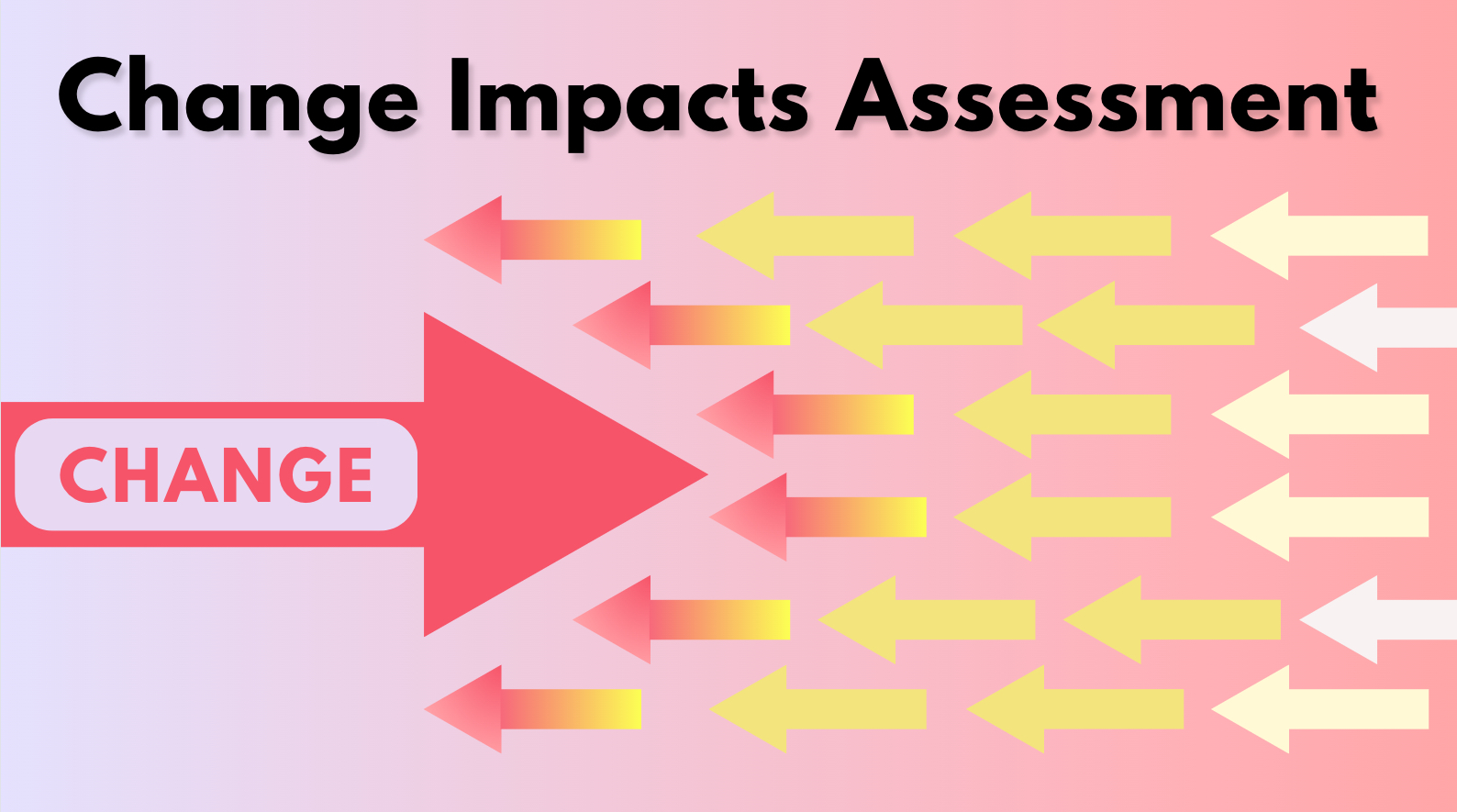
All-in-One Impact Assessment Tools & Change Management Tools
Step-by-Step Change Impact Assessment Process with Templates and Samples
As mentioned above, an organizational change impact assessment is a critical component for increasing the success of an organizational change (technology, process, culture, etc.), and it serves as a foundation for many other parts of the change management process.
The information in this guide can help for a system impact assessment, IT impact assessment, software impact analysis, customer impact assessment, impact analysis company M&A, stakeholder impact analysis, and any other type of business impact examples you may have (process, culture, strategy, expansion, etc.)
Change management and impact assessment practices are fast-paced and dynamic fields. It can sometimes be frustrating, especially if you’re relying on outdated change impact analysis templates, matrices, frameworks, and processes that no longer work.
You’d be surprised at how many companies are still struggling with a business change impact assessment template Excel sheet that is clunky to use. It’s vital in today’s business world to use a collaborative cloud-based business impact analysis template that can be accessed from any device by multiple users and that automates your reporting analytics.
It’s crucial for you to stay well-informed and learn continuously. To support change practitioners and project management resources in their change impacts activities, this guide also references OCMS Portal’s best-in-class Business Impact Analysis Toolkit with Template and Sample Data that you can leverage to enhance your change impact performance and save time.
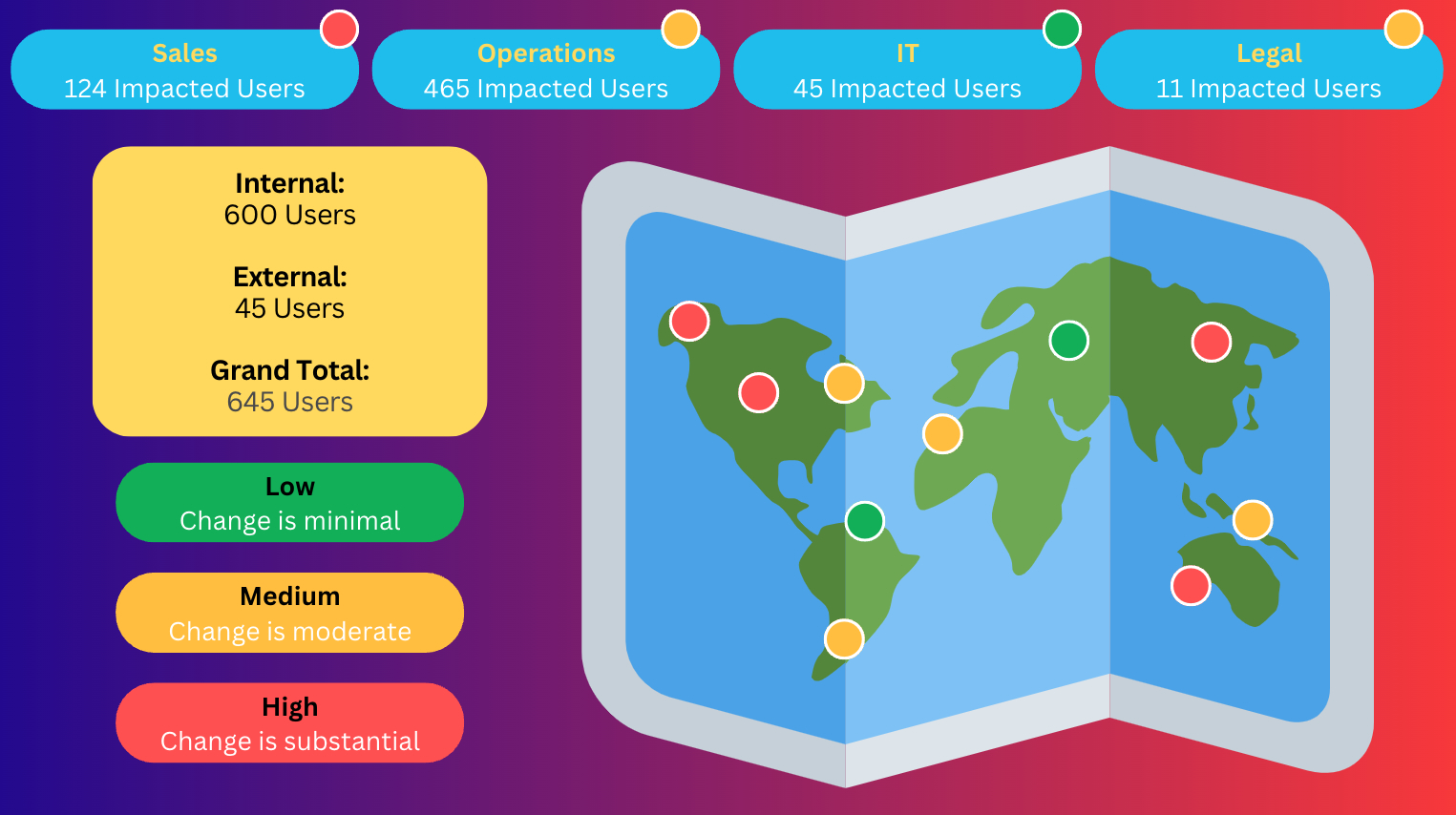
Example of a change impact assessment heat map
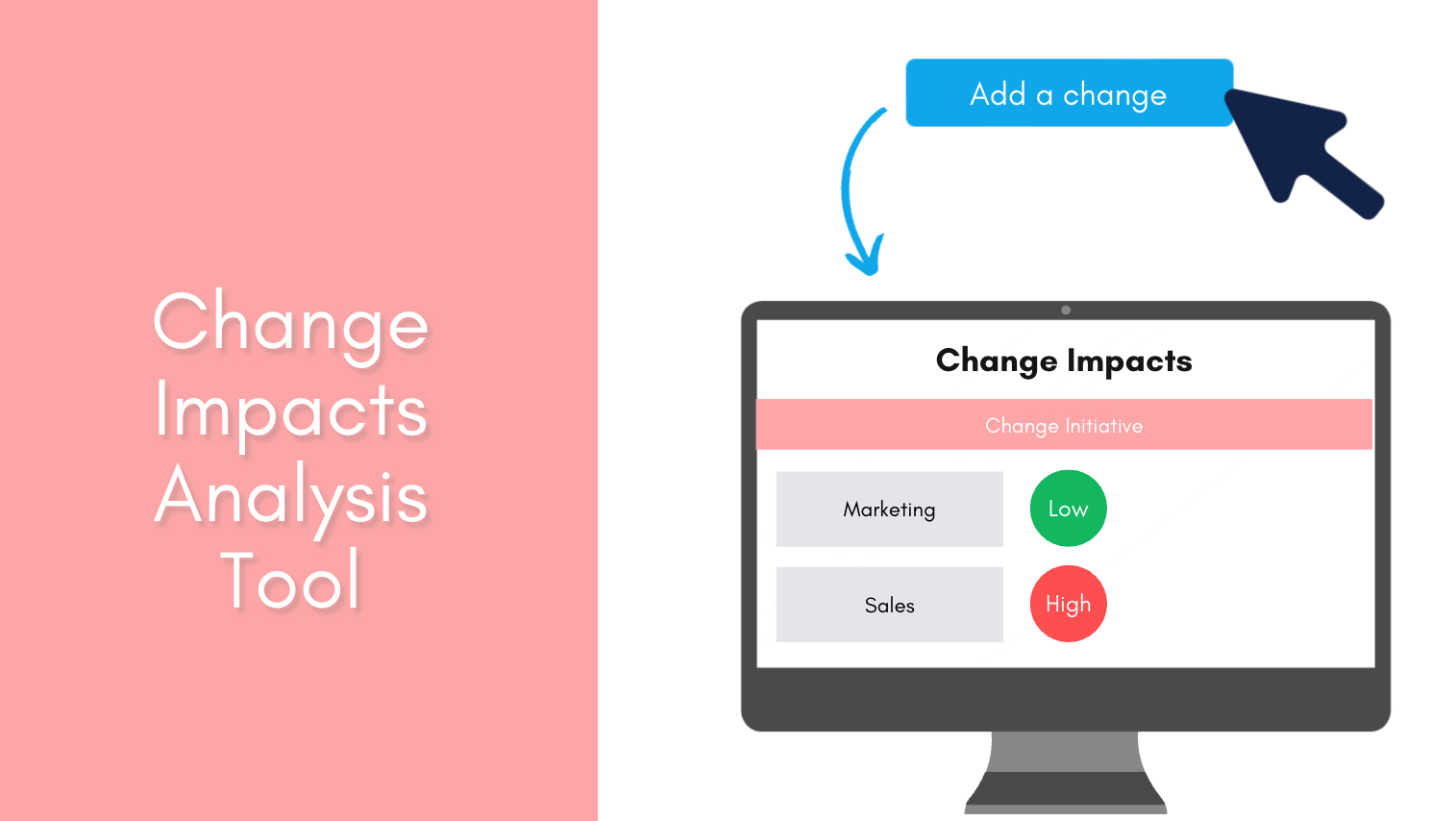
Looking to revolutionize the way you do change management? Look no further than OCMS Portal. Start your free trial today.
First, What is an Organizational Change Impact Assessment Definition?
What is a change impact analysis?
A change impact assessment involves a current state vs. a future state assessment of how people, processes, systems, policies, data, and more will be impacted by an organizational program.
Another way to define change impact assessment is that it is the set of change tasks that you perform to analyze the impacts of a change within an organization or region.
When an organization transforms its processes, culture, systems, skill set, values, policies, or technology, or when it expands to new locations, produces new products, or changes its operations, there are individuals and groups that are impacted by this change.
Do You Need to Assess Both Internal & External Impacted Groups?
A key component of an effective impact analysis is to assess internal audience groups. However, in addition to assessing the impact of change on your internal groups, it might be important to do a change management assessment for any external groups that may be impacted by a business project.
This may include customers, vendors, affiliates, etc.
Knowing who is going to be impacted – internally and externally, how they’re going to be impacted, and the severity of that impact is critical if you want to implement your organizational change project successfully.
- Conducting a business change impact analysis allows you to identify the groups, departments, functions, teams, and job roles that will be impacted by the change.
- Conducting a “system impact assessment” or “software change impact analysis” allows you to identify the specific business processes and legacy technology tools that will be impacted (or replaced) by a technology level change.
- Conducting an organizational culture, mindset, or operational change impact analysis enables you to identify the groups and individuals that will be impacted and who needs to be enabled and supported through the change.
The impact analysis definition and how you define impact analysis in your organization can differ from another organization. When researching, “how to do a change impact assessment,” you’ll see that the definition of “impact” will typically include several attributes of change.
Change management risk and impact assessment will generally identify the following as impacts that need to be assessed and managed for a project to be successful:
- Change in job role
- Change in job duties
- Change in process
- Change in software
- Change in equipment/hardware
- Change in corporate culture
- Change in organizational structure
- Chance in policies or procedures
- Change in products/services offered
- Any other changes that mean the adoption of a new way of doing things by employees or external groups (vendors, customers, etc.)
OCMS Portal Change Assessment Toolkit
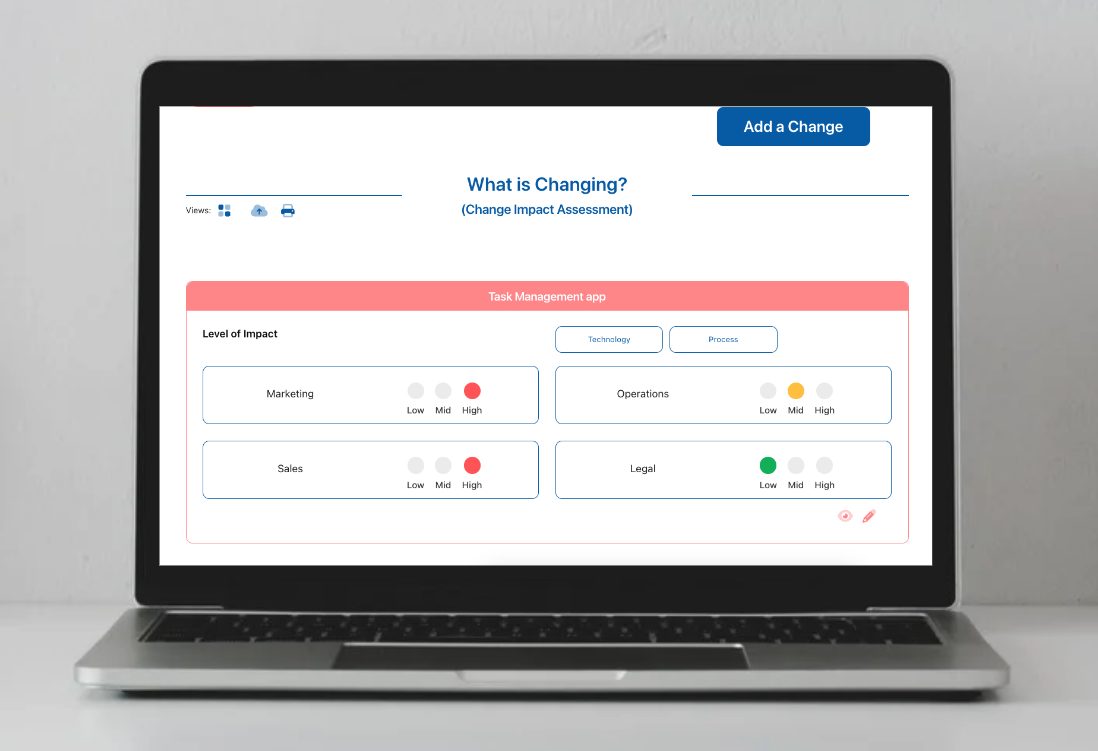
Change Impact Assessments done right with OCMS Portal. Get a free trial now.
Do you have more impact analysis example samples that you would like to see included in this guide? Please reach out and let us know.
Other Types of Change Impact Assessment?
Businesses account for over 80% of impact analysis projects, but businesses are not the only ones that go through change.
Our climate is ever-changing and there are organizations and agencies that regularly must conduct climate impact assessments. In addition, countries around the world continue to experience social, economic, and environmental changes which require social impact assessments (SIA), environmental impact assessments (EIA), and privacy impact assessments (PIA).
Conducting these other types of impact evaluations allows organizations to identify the people, groups, regions, policies, social-economic segments, practices, and behaviors that will be impacted by a change.
If you are interested in reading about these other types of assessments, including a step-by-step overview, templates, and tools, click below.
- Data Protection Impact Assessment (DPIA)
- Social Impact Assessment (SIA)
- Privacy Impact Assessment
- Economic Impact Analysis
If you’re interested in the best practices for end-to-end business change assessments, keep on reading this article.
This guide is geared towards the most common impact analysis & practices, which are for change impact assessment and planning.
The Positive Impact of Change Management on Projects
Why incorporate a change impact assessment report and process into a project?
Because projects often fail when the people that need to adapt to the new project’s impacts on their daily workflow aren’t properly prepared.
A company may decide to adopt a new CRM software. As part of the project, licenses are purchased for all customer support reps. Once the customer data is transferred over to the new system on the backend, the team is told to begin using it. At this point, the company leadership may think the project is successfully completed.
But without any change management, users can be left uncertain of what to do. They may not like the new software or not know how to use it, and thus, customer data isn’t being captured in the new system as it should. The project adoption fails, and thus the project fails.
The impact of change management on that CRM project would have helped ensure the new software was adopted successfully. It would do this by first looking at the impact of change on an organisation (UK spelling) or organization (US spelling).
Once a stakeholder impact assessment and customer impact assessment were completed, the change management team would know who to begin engaging with through communications, coaching, training, etc. to properly prepare them and ensure everyone was trained on and familiarized with the new software.
Statistics on the Positive Impact of Change Management on Projects
Several studies show how project outcomes are improved when change management is used to guide impacted stakeholders through a change.
Here are a few of the statistics that illustrate the advantages of using change management and impact analysis best practices in a project:
- Projects using change management saw 143% of the expected ROI from a project, versus just 35% for projects with little to no change management.
- Projects have an 81% probability of coming in under budget vs projects with poor change management at a 48% probability.
- Projects using change management assessment practices are 6x more likely to achieve project objectives than those that don’t.

A risk and impact analysis change management process can increase a project’s ROI significantly.
In Which Phase of Your Project Should You Conduct an Organizational Impact Analysis?
If you are using a change management framework, such as the OCM Solution Change Management Framework, Prosci change impact assessment methodology, Deloitte change impact assessment example, or another model like the McKinsey change model, you’ll find that different change activities are performed at different phases of a project.
For example, the OCM Solution Change Model has five phases:
- Phase 1: Assess
- Phase 2: Develop
- Phase 3: Deploy
- Phase 4: Normalize
- Phase 5: Exit
The Business Impact Assessment for change is performed in Phase 1 because it’s one of the first things needed to inform the other activities in your change management project.
For example, you can’t really conduct a full stakeholder impact assessment until you know which organizational groups will be impacted by the change. This is an answer that a change impact statement from your analysis can provide.
Another example would be communications planning. You need to know which groups and stakeholders you need to communicate with before you can plan your engagement activities. Impact analysis in change management identifies who will need to be included in your communication plan.
What is impact analysis? It’s a foundational element of your project that needs to be completed as early as possible.
Whether you are using the change impact assessment Prosci method, OCM Solution impact analysis change management framework, Deloitte change impact assessment matrix, or another model, defining change impact and providing a business impact analysis template is one of the first change management activities you will do.
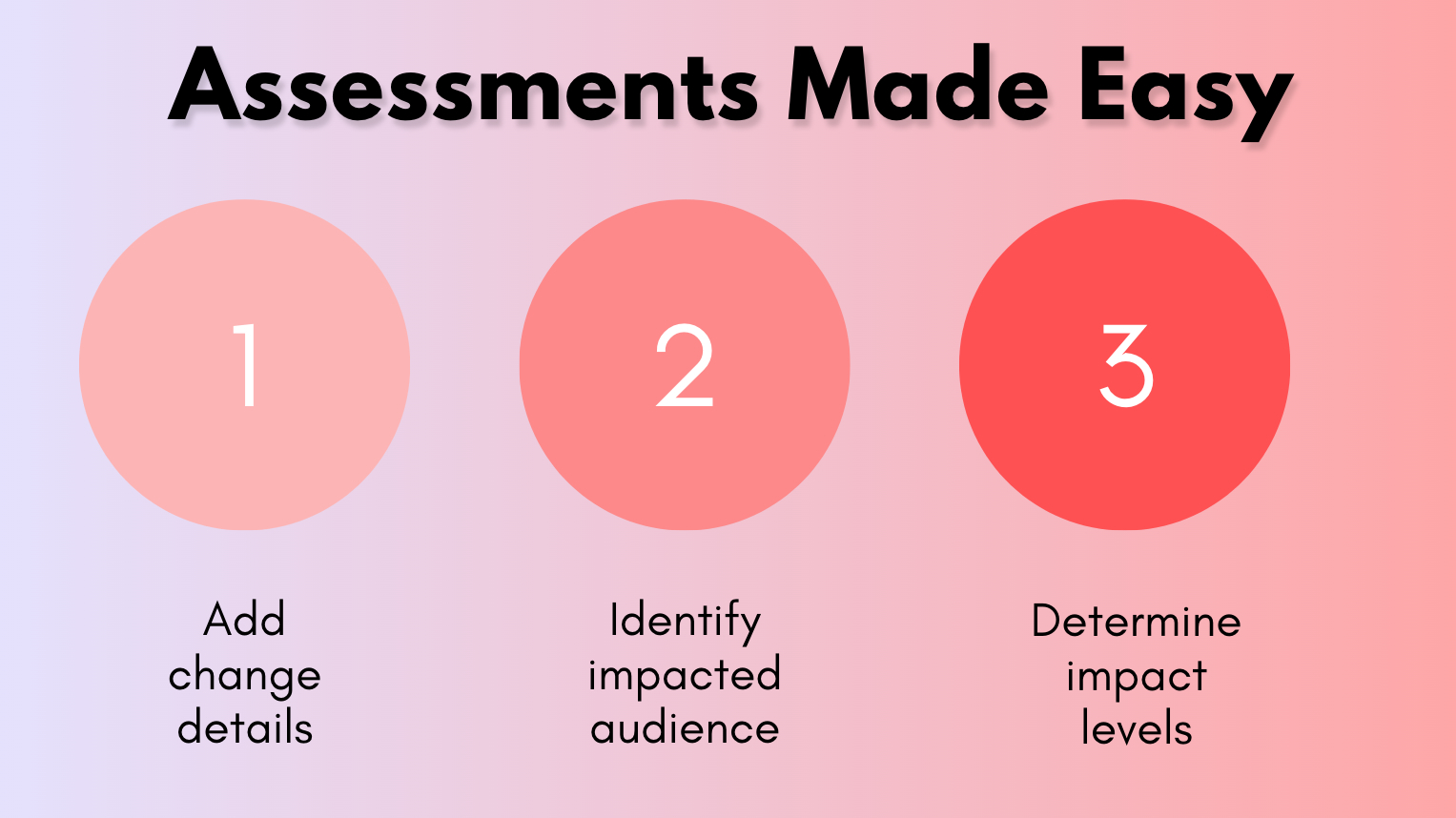
Seamless change impacts analysis with real-time analytics. Only with OCMS Portal. Click below to get a free trial:
Do you have any questions or feedback related to a business impact assessment example, change impact assessment meaning, or how to do impact analysis for projects? If so, click here to contact us.
How Important is the Output from Your Organizational Change Analysis?
The findings from your change impact assessment are extremely important as they will drive the development of your change management and project management strategies.
For example, your project, change enablement, and program plans for communicating, engaging with stakeholders and firm leadership, training impacted end-users, coaching, and supporting impacted stakeholders and employees will be based on the severity and scale of the impacts.
A higher level of change impacts to a specific group (for example, the Sales group) will mean a more comprehensive level of communication and engagement with Sales staff to increase their buy-in and acceptance of the change. It will also mean more training relative to less impacted groups.
How Does an Impact Assessment Impact Other Change Processes?
- Tells you the level of training needed for users/groups
- Tells you the type of communications needed for users/groups
- Tells you where you need change agents to help with change support
- Identifies where you’re likely to get the most resistance to the change
- Tells you what types of job role guides and documentation you’ll need
- Identifies which specific processes/procedures/software/systems are changing due to the project
The impact assessment change management analysis tells you where to direct your stakeholder engagement and identifies which groups require the most engagement.
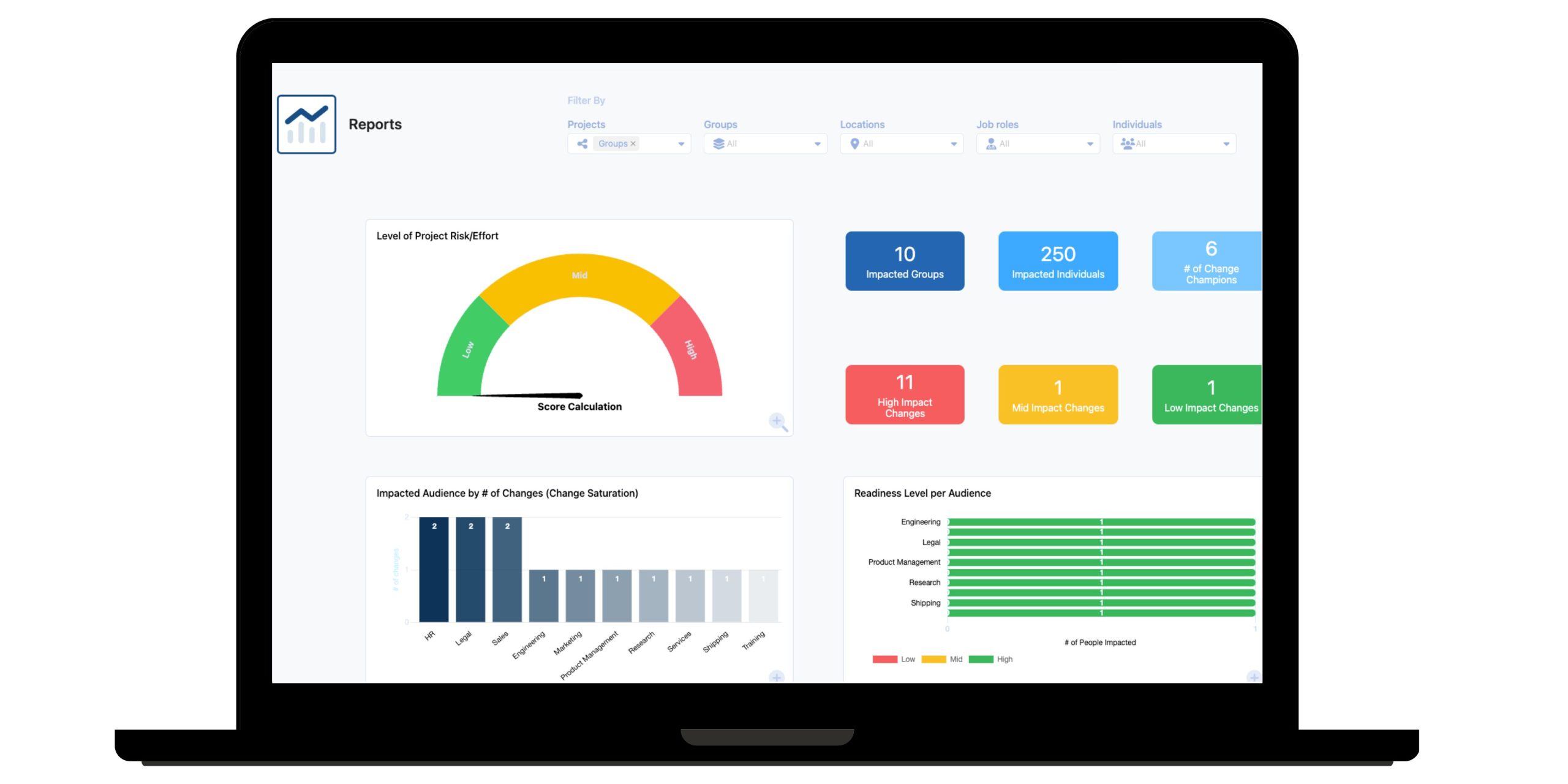
Change Impacts Tool – with Automated Business Process Analysis Template Reporting
OCMS Portal Impact Assessment Reporting Dashboard
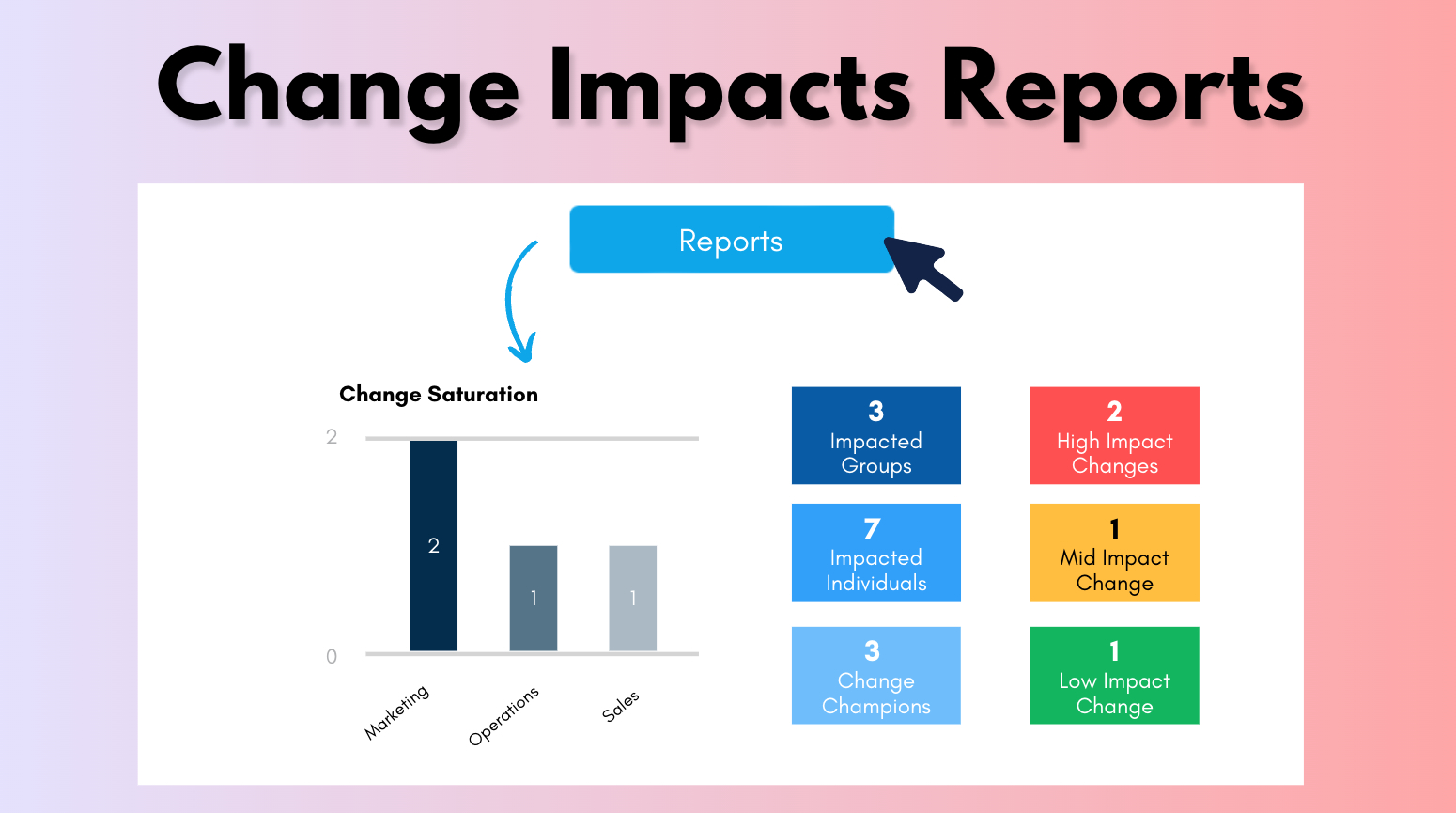
Get the Change Impacts Assessment Tool included in the OCMS Portal All-in-One change management software and boost your change management success. Try the OCMS Portal for free.
A Best Change Impact Assessment Framework & Methodology for Change Managers
The section below this one provides you with a list of process steps to take for conducting an effective impact assessment for changes to people, processes, tools, software, systems, and solutions.
But first, let us quickly summarize an industry-standard change impact analysis framework that you can apply when doing your change analysis.
A change impact analysis is nothing more than comparing the current state (As-Is) to the future state (To-Be) and then understanding what is changing, who is impacted, what processes and tools will be impacted, and the severity of impact to people, processes, and tools.
As you conduct your impacts review and evaluations, keep in mind that you must capture the current state (as-is assessment) and the future state (to-be assessment) and then document the delta (aka what exactly is changing).
See the below image for a simple change impact assessment framework and methodology that you can leverage for your purposes.
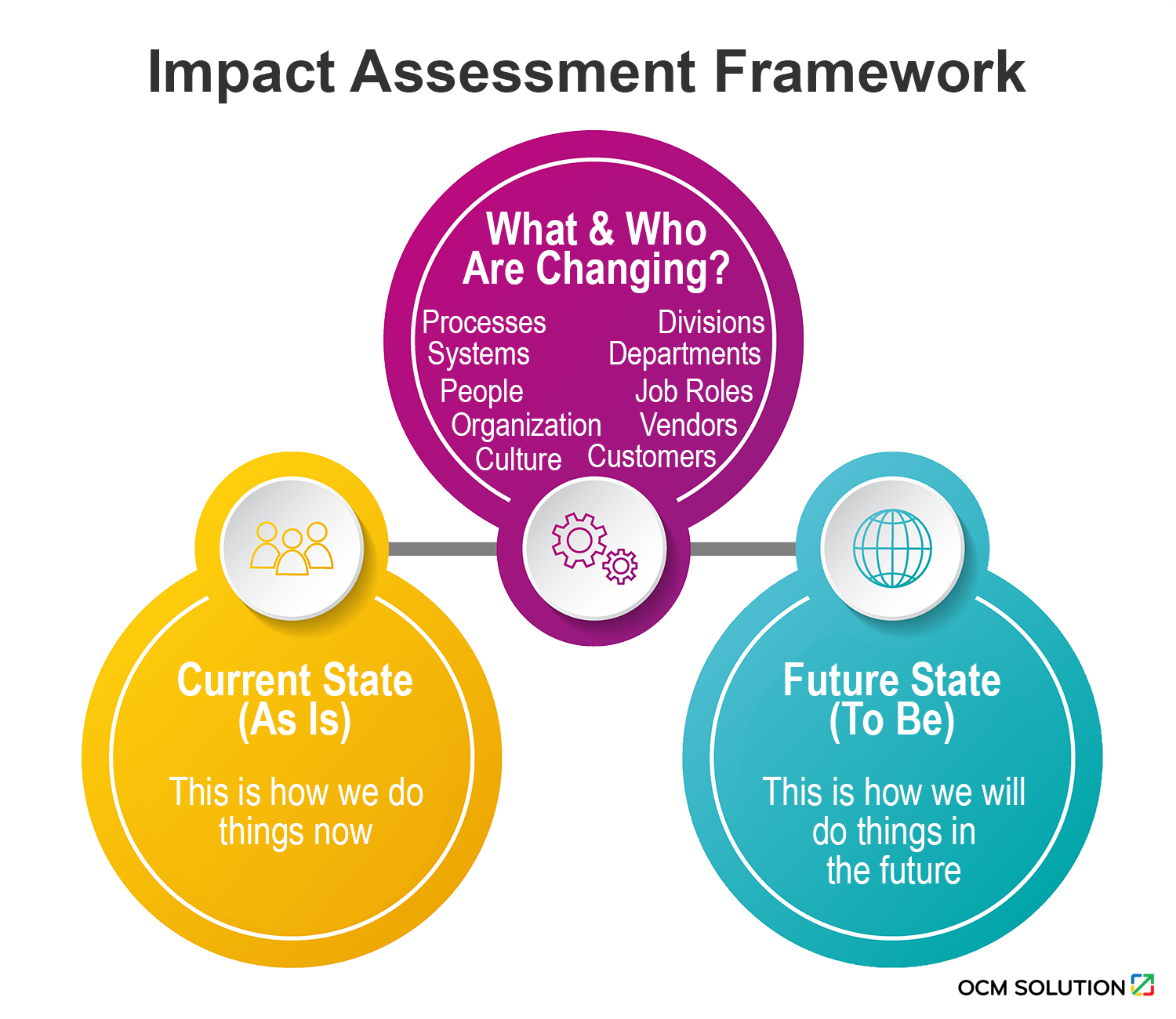
Simple-to-use impact assessment framework | Current State vs Future State Template
Business Impact Analysis Questionnaire (As-Is Assessment):
- What processes will go away?
- Who is currently using processes that are going away?
- How much effort will be involved in the transition?
- What systems, upstream, and downstream interfaces will need to adjust?
- Which groups & roles use the interfaces that are changing?
Business Impact Analysis Questionnaire (To-Be Assessment):
- What new processes will be implemented that didn’t exist before?
- Who will use the new processes?
- How much effort is needed to enable the adoption of the new processes?
- What new systems, upstream, and downstream interfaces will be adopted that did not exist before?
- Which groups and job roles use those interfaces?
- Which groups and job roles will need to perform their jobs differently after the transition?
- How much effort is required to transition the impacted people from the current state to the future state?
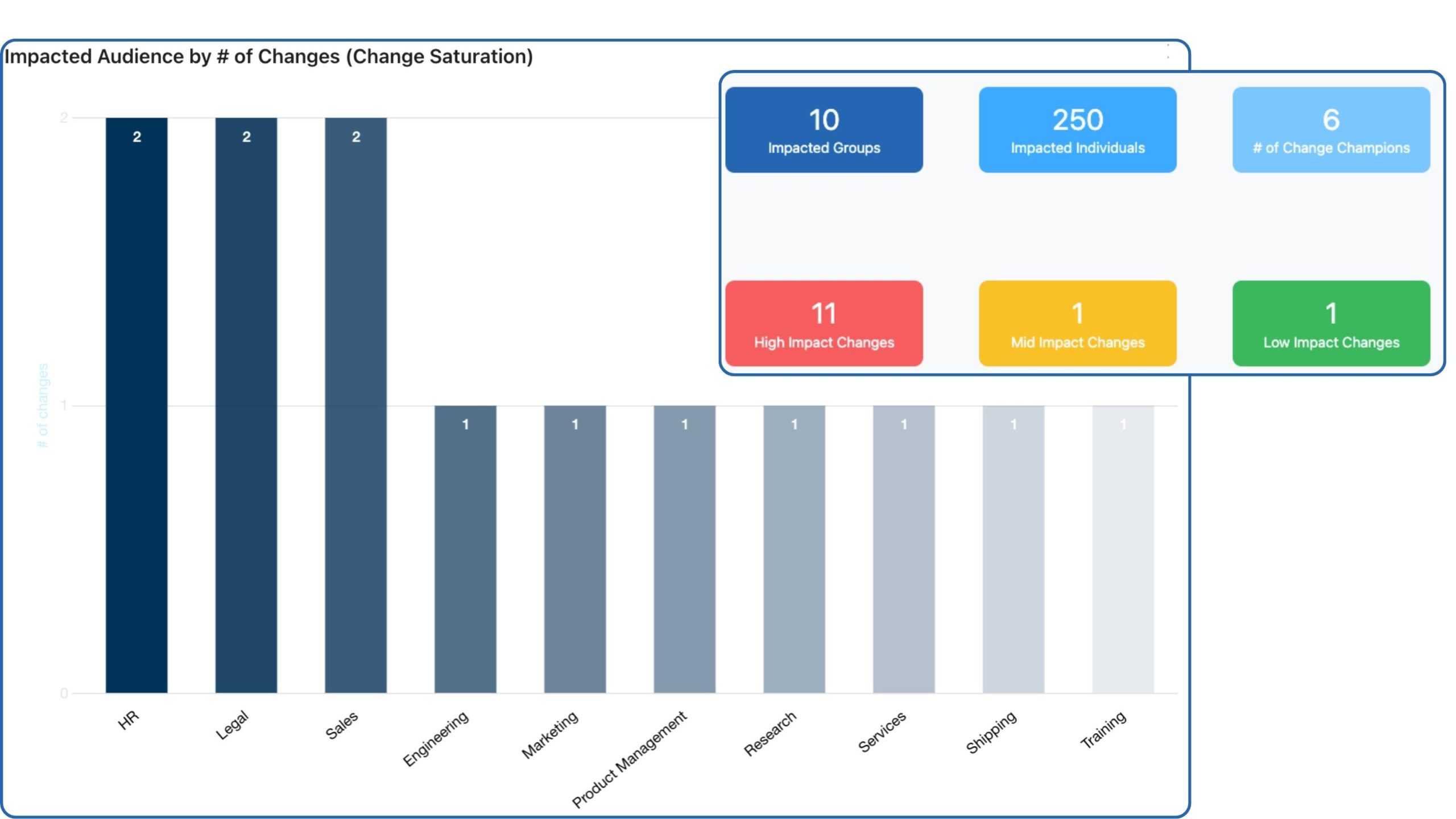
Start your OCM journey with the keys to success and try out OCMS Portal for free today.
Do you have any questions, feedback, or input about the impact analysis example samples, or business impact analyse templates referenced in this guide? Please reach out and let us know.
End-to-End Process for Conducting Your Change Impact Assessment
Overview: How to Conduct the Best Impact Analysis for Change
Next, we will provide an overview of the assessment steps for the impact of process change, culture change, organizational change, system change, or another type of organizational change.
It’s helpful to use a change impact analysis checklist as a guide for conducting the activities in your impact assessment. This helps make how to do an impact assessment less overwhelming because you can focus on the activities in one step at a time.
Using change impact analysis best practices, OCM Solution has created a change management impact analysis template that divides the process into eight steps. This is designed to make the organizational impact assessment (or UK spelling: organisational impact assessment) comprehensive.
Each of the eight steps in the change impact analysis checklist available in the OCMS Portal Change Impacts Tool will have various activities or tasks to be accomplished to complete that step of the impact analysis in change management.
The activities that we’ve detailed below in the following sections can also be leveraged to use with other business impact analysis template frameworks. Such as a Prosci impact assessment, an ITIL change impact assessment, Deloitte change impact assessment, a stakeholder impact assessment, a customer impact assessment, a code change impact analysis, an impact assessment project management model, or any other framework.
Following is an overview of our 8-step change management assessment tool. In the following sections, we will detail the tasks to accomplish for each of these steps. Feel free to print this out to use as a “cheat sheet” for how to conduct impact assessment activities.
Business Impact Analysis Steps:
- Step 1: Learn (Gain an understanding of the project)
- Step 2: Define (What impact assessment methodology, metrics, and assessment tools are being used?)
- Step 3: Gather (Identify and request project change impact analysis document assets)
- Step 4: Assess (Conduct the business impact analysis)
- Step 5: Interview & Update (Meet with impacted managers to detail group impacts & update project impact assessment report)
- Step 6: Socialize (Review your project impact analysis with key project leads and impacted stakeholders)
- Step 7: Finalize (Incorporate input and finalize your change management impact analysis)
- Step 8: Monitor & Update (Monitor for new change impacts & update the business change analysis)
Next, we’ll explain each of the steps in this change impact analysis checklist in detail.
Test drive OCMS Portal and the Change Impact assessment tool for free. No credit card needed.
Do you have any questions or feedback related to this “business impact analyse” and “impact change assessment” article? If so, click here to contact us.
Are you looking for ITIL change impact assessment information for a code change impact analysis, change request impact assessment, impact analysis document for change request for technology, or change control impact assessment? If so, read about these in our article, “Top Guide to Best ITIL Change Management Processes & Practices.”
Step 1 (“Learn Stage”) of the Impact Assessment Process
Step one of the change analysis framework is the “Learn” stage. It involves gaining an understanding of the project.
The first thing you need to do as part of your impact analysis steps is to understand the project in detail.
The earlier the change management component of a project is brought into the project management process, the better. However, as is often the case, the impact assessment meaning may not be realized until later, and the change management team may be playing catch up.
Before you can begin any detailed change impact assessment report, you need to know what the project is about. This includes:
- The reason for the project (the issue the project is trying to solve)
- The benefits and goals
- The scope of the project
- The timeline
- The process flow before and after (i.e., the current state future state template)
- The sponsors & team members driving the project
Meet with the Project Team
It’s best to do this by meeting with the project team and having them get you up to speed on what the project is about. It’s also helpful to request the opportunity to sit in on project team meetings so you can gain an understanding of the project scope and any changes in the project deployment that might happen midstream.
Identify the Resources Tasked with Documenting the Business and Process Flows
Business Analysts are often the Resources tasked with conducting process flow mappings. A process mapping involves documenting the end-to-end flow of the current state for a particular system, culture, process, organizational operations, or any kind of “current way of doing things”. It also involves mapping out the future state processes as part of the future state design initiative.
You want to identify the resources (internal teams or external consultants) mapping the current state vs future state template so you can meet with them to get a detailed overview of everything that is changing and that will impact people inside and outside the organization.
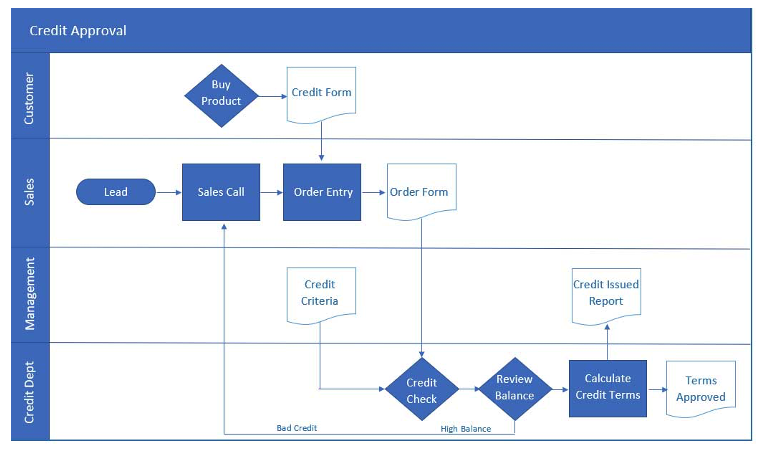
Sample process flows and mapping that inform the impact assessment process.
Check out the OCMS Portal As-is vs To-be assessment template toolkit.
Step 2 (“Define Stage”) of the Change Assessment Framework
Step two of the business change assessment process is the “Define” stage. It defines what impact assessment methodology, metrics, and assessment tools are being used.
Now that you have an understanding of the project, you’ll want to put some frameworks in place to structure your impact assessment in change management.
The change impact assessment process will go more smoothly if you put these structures in place now before you go any further. Now that you have a basic understanding of the project, you should be able to identify the type of impact assessment methodology and change impact assessment tools (software, spreadsheet, etc.) the change management team will use to organize the business impact assessment and other change management activities.
Additionally, you’ll want to define the metrics you’ll be using to gauge the level of change impacts so you can prioritize your engagement with impacted groups.
What is change impact analysis when it comes to choosing metrics?
You want to use an easy method to identify two important factors for each impacted business unit, organizational group, job role, or external stakeholder:
- The severity of impact that the change will have
- The magnitude of impact the group is going through (how many project changes are they dealing with?)
If you use a “high, mid, low” gauge for the severity of impact, as we do in the OCMS Portal business impact assessment template, then you will want to define your metric for each level.
Some business impact examples for an impacted job role would be:
- High = 50% or more of job role tasks are changing
- Mid = 30-49% of job role tasks are changing
- Low = Less than 30% of job role tasks are changing
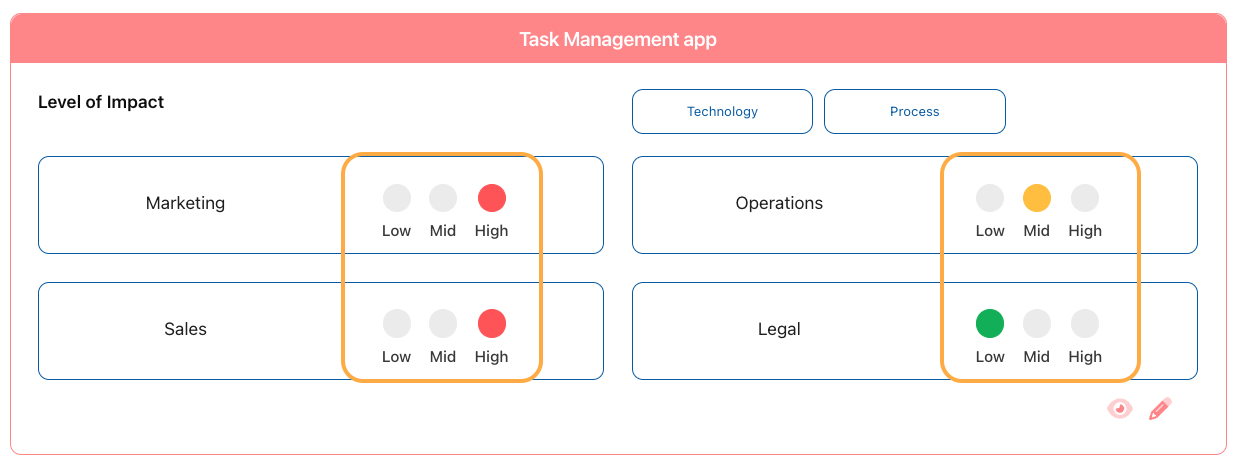
OCMS Portal Business Impact Management Template with a severity of impact indicator.
Highly impacted groups require a higher level of change management engagement to ensure they are on board and ready for the change.
The magnitude of impact is another important metric to look for when learning how to conduct impact analysis. A group that might seem to only have a low impact from this project, might also be having impacts of any severity from other projects. The more projects – more change – groups have to go through (i.e., their “magnitude of change”), the more risk there is of change fatigue.
If you don’t understand the magnitude of impacts for a group you’ve identified during your stakeholder impact analysis, then even if that group is having a low impact from this change, they could end up causing problems for project adoption due to change burnout.
In Recap…
During step two of the business impact analysis steps, you want to decide on and put in place:
- Your guiding impact assessment methodology
- The change management assessment tool or software you’ll be using
- Details on the metrics for which you’ll judge the severity of the impacts
Change Management Analysis Templates
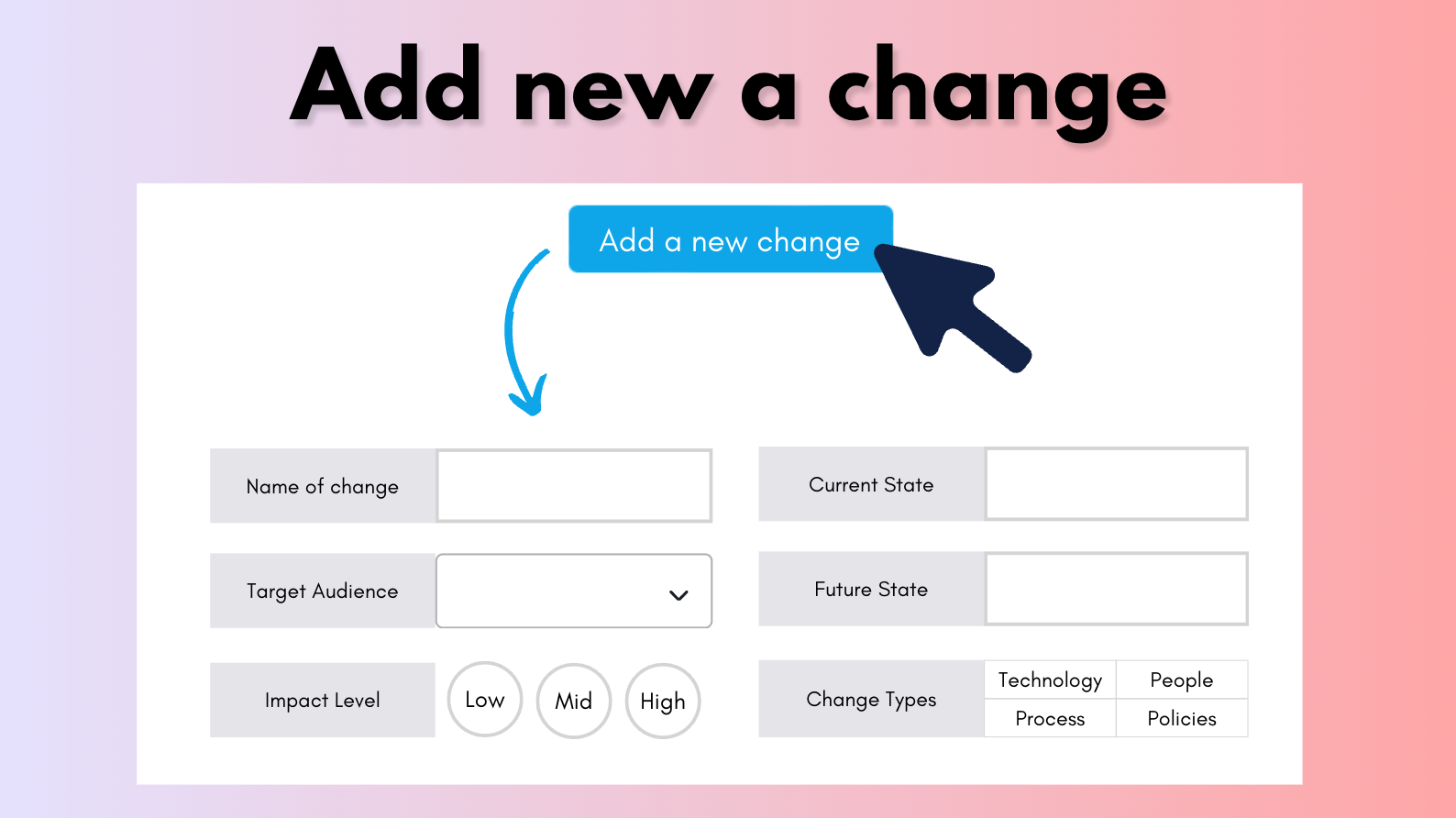
Dive into the future of change management. Embrace simplicity, harness power, and save time with OCMS Portal. Start your free trial today.
Step 3 (“Gathering Stage”) of the Impact Assessment Methodology
Step three of the business change assessment process is the “Gather” stage. It involves identifying and requesting project change impact analysis document assets.
Now it’s time to gather the information you’ll need to conduct your organizational impact analysis. This will consist of various project documentation, as well as any personnel and departmental lists you can leverage.
When conducting change impact assessments, you should gather process flows, information on behaviors and cultures, pertinent organizational lists for departments and job roles, and documentation on the change.
You’ll then enter this information into your business impact assessment template. (Either a cloud-based business impact analysis template or change management impact assessment template Excel sheet.)
Are you conducting a software impact assessment? Then make sure you are gathering information on the current software as well as gathering information on the future software that the firm will be moving to. If you are doing a system impact assessment, then ensure that you are gathering information on the existing system infrastructure which will then be used to do an As-Is versus To-Be system-level impact assessment.
If you are creating your own change impact assessment matrix from scratch using Excel, Smartsheets, or some other spreadsheet, make sure that your change impact analysis template Excel includes a column for listing the current state (processes, culture, people, mindset, social, climate, etc.), another column for listing the relevant future state processes, and another column for capturing the differences (the delta).
It should be similar to the OCMS Portal 360° impact assessment template which is based on impact analysis best practices.
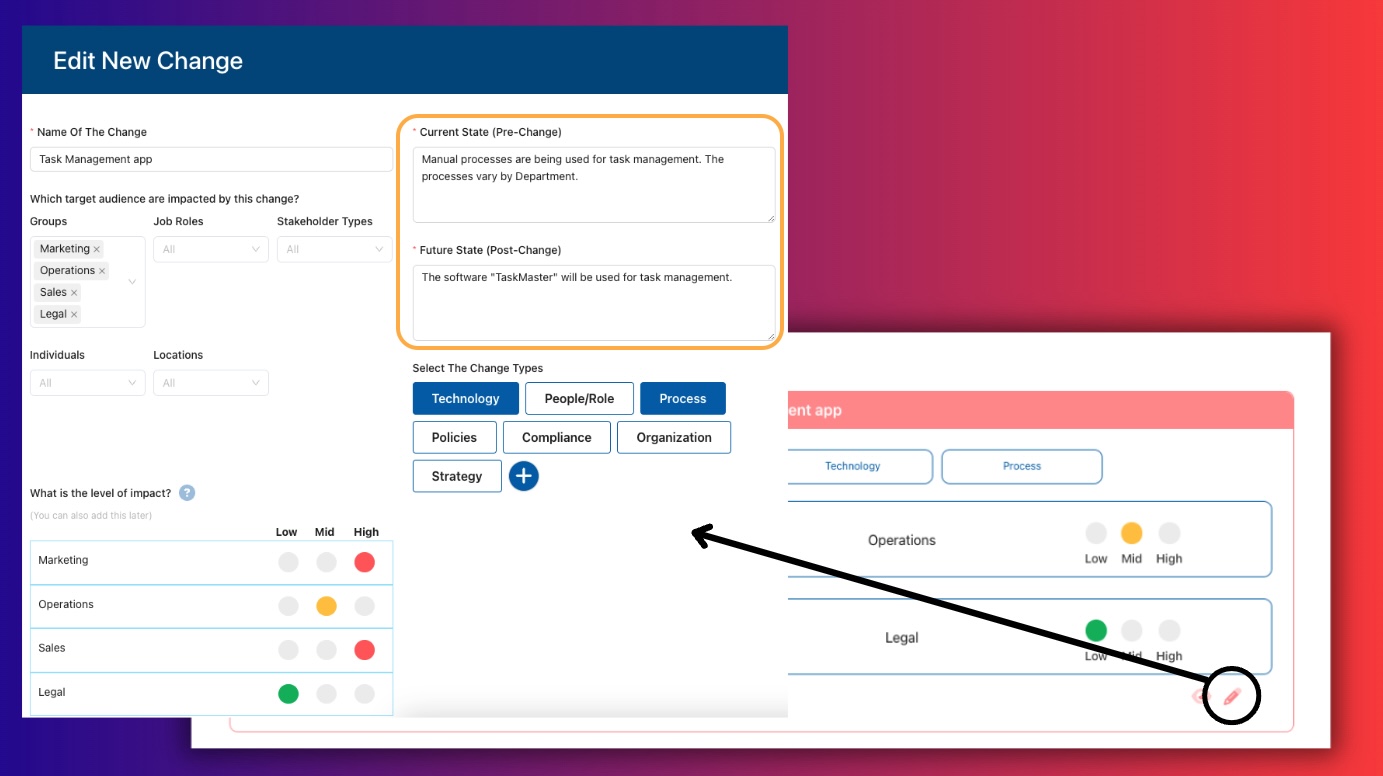
OCMS Portal Impact Assessment Tools with As-Is and To-Be inputs
Change Impact Assessment Framework: Key Information to Gather as Part of Your Impact Analysis
When performing your business change impact assessment, it is essential that you apply a structured change impact assessment framework.
Key data points that you will need to gather as you perform your business change impact analysis include reviewing process flows and mappings of the current state vs future state template. This means learning in detail what the current state is now (as-is assessment) and what this is going to change (to-be assessment) to satisfy the needs of the change project.
This will allow you to identify the change deltas; in other words, what is changing between the current state and the future state.
You’ll also need to identify and document which groups and job roles will be impacted, as well as what are the severity and levels of the change impacts, and most importantly, what does the change management team need to know (input for change management).
Tip: Ask for a list of all organizational groups and employees, including their job roles from the HR department, or the appropriate department. This will save you time when it comes to populating your business impact assessment template.
List of Potential Documents to Request
Here are some of the common documents and files you may want to request that will help you with your change impact assessment:
- Project Charter
- Current and future state process flows
- Project timeline or calendar
- Vision Document
- Work Breakdown Structure (WBS)
- Organizational chart
- Spreadsheet of organizational groups, job roles, and employees
- List of other current, future, or past projects (which will help you gauge potential “change fatigue” by a group)
- List of any existing or former change agents or change champions in the organization
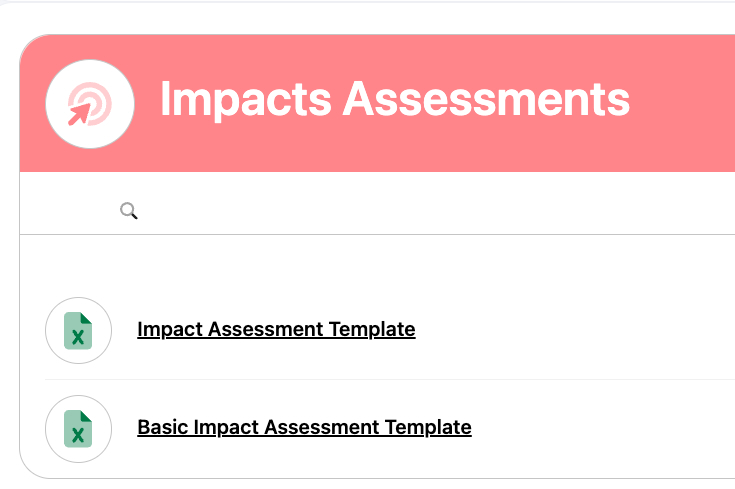
You can use OCMS Portal’s #1 Ranked Change Impact Assessment Tool, to keep all your gathered data in one place. This tool is an online change manager that is designed to help you plan, manage, and execute a successful change project. It enables effective business impact management with real-time analytics and impact assessment examples.
Step 4 (“Assess Stage”) of the Impact Assessment Process
Step four is the “Assess” stage, and it involves conducting the end-to-end assessments.
It is generally the role of the change management practitioner to perform the impact analysis. However, if you can get the Business Analysts performing the process flow documentation to also do the impacts assessments, that will free up your bandwidth to focus on other vital change management tasks.
Two ways for conducting your impact assessments steps
- Ask the Business Analysts / Other Resources to conduct the assessment
- Complete the assessment yourself
The two sections below describe how the two methods listed above can be completed.
(4.1) Ask the Business Analysts / Process Mapping Resource(s) to follow the business impact analysis steps
- You will want to start by meeting with the Business Analysts or other identified resources and explain the importance of conducting a change impact analysis. Using a diagram, suggest what activities might be involved in change impact analysis.
- If they are new to the process, then you will also want to answer, “What is change impact analysis,” including providing them with a preview of the impact assessment framework discussed above.
- Provide the resources with a copy of our Change Impact Assessment Template, for capturing the impacts information, and walk them through how to do complete the impact assessment matrix.
- Emphasize the need to populate the impacts template with succinct but meaningful As-Is vs To-Be information. They can use our business impact analysis samples for illustration of what needs to be completed.
OCMS Portal Change Impact Tool’s Assessment Template with Sample Data
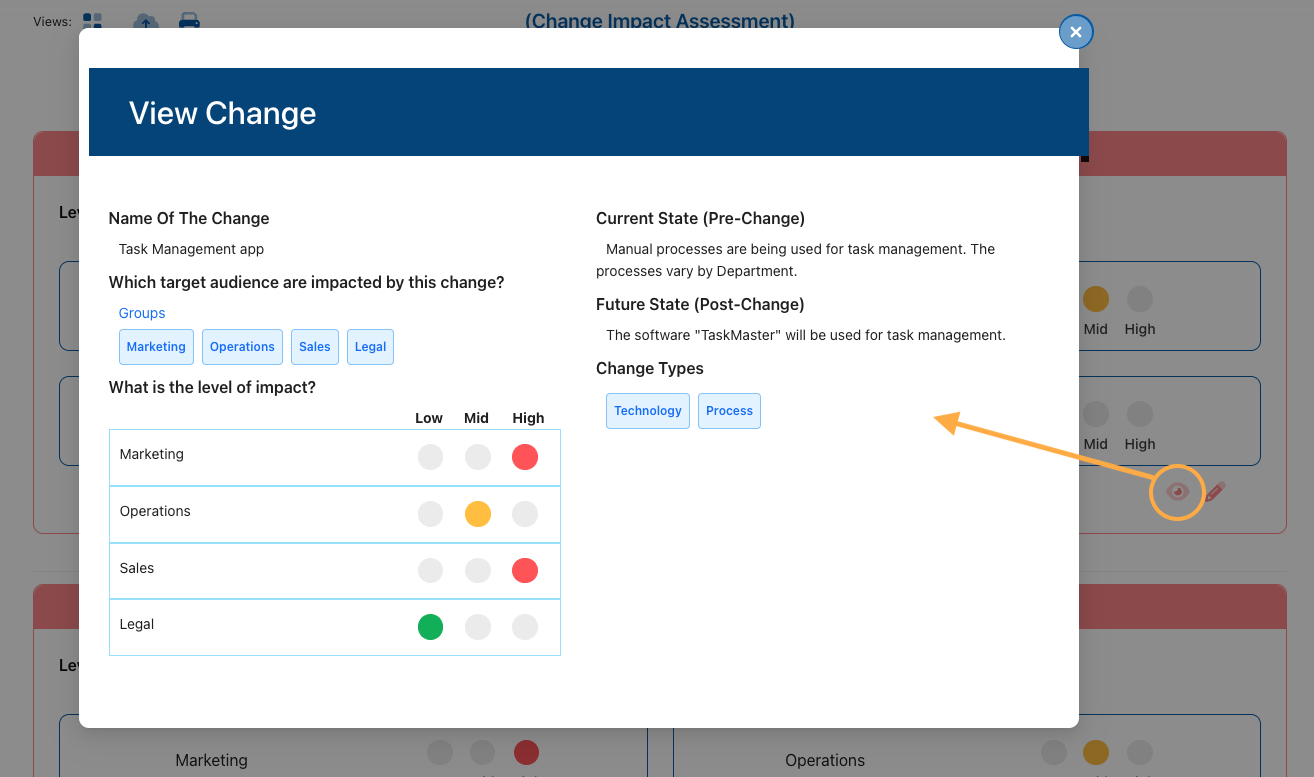
Change impact analysis example template
- Using the As-Is and To-Be process flows that have been created or that are in the process of being created, the Resources will then populate the project impact assessment template which will flow into your OCMS Portal Change Impacts Analytics Dashboard for insights and holistic reporting.
- Using a tool like OCMS Portal with real-time analytics saves considerable time when analyzing the data because there are no reports to build like you usually have to do with a change management impact assessment template Excel sheet or a change impact assessment template free download.
OCMS Portal Change Impact Tool’s Analytics Dashboard with Sample Data
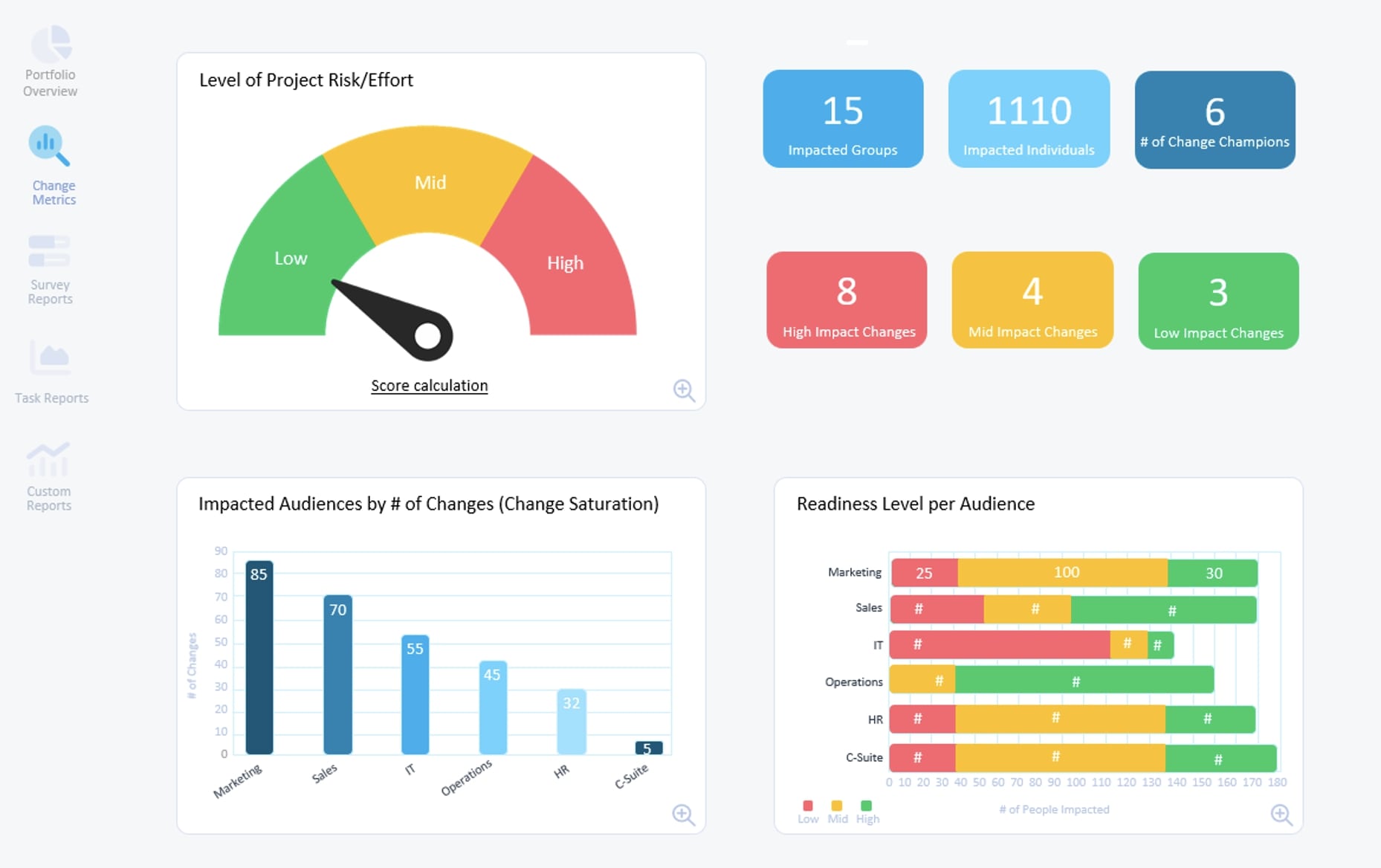
Business impact analysis example report
- Throughout this whole process, make sure that you are following up with the Resources regularly to check on their progress for completing their business impact analysis steps.
- Also, ask them to provide you with an estimated completion timeline, and then track their progress towards this promised delivery timeline.
(4.2) Conducting the change impact assessment yourself
If the above option of getting other Resources to do the change impact assessment is not viable, then the second option will be for you (if you are the Change Management Resource) to complete the end-to-end impact review and documentation by yourself.
So how do you perform the most efficient, simplified, and yet impactful change impact analysis? See below for a list of the action steps you should take to help you identify the effects and impacts of a business change:
- Review the answers to the change impact assessment questions you asked of the project team when you met with them in Step 1.
- Examine the documentation you gathered in Step 3. This may include business process flows, technical flows, project scope, and other current and future state documentation from the project team, program sponsors, architects, designers, and other groups.
- Use the metrics and impact analysis definition or change impact rating scale you defined in Step 2 to designate the level of change impact for each organizational group and job role.
- Populate the various sections of OCMS Portal’s Change Impact Assessment Template yourself. Leverage the end-to-end sample data that is included in the OCMS Portal tool to increase your success.
- Conduct interviews with the project team, Work Stream Leads, architects, designers, stakeholders, and SMEs to get alignment and to ensure that you are capturing the right data.
- In addition, you should review one or more of the below documentation types to glean additional information that should be entered into your change impact assessment matrix template:
- Design Planning Workshops
- Map Day Workshops
- Functional Decomposition & Architecture Diagrams
- Business Process Flows
- System User Lists
- and more…
What to enter in your group and stakeholder impact analysis template:
- As-Is assessment of the current state
- To-Be assessment of the future state
- Summary or name of the change
- The organizational group and job role being impacted (use different rows for each one)
- Regional details, if applicable
- Severity of impact (Use the change impact rating scale defined in Step 2)
- Designate the type of change (process, culture, roles, etc.)
- Any tasks being assigned or additional notes
Do you have any questions about “conducting the change impact assessment yourself” or the “change impact assessment workshop” If so, click here to contact us.
Step 5 (“Interview Stage”) of the Organization Assessment Process
Step five involves the “Interview” stage. During this stage, you will be meeting with impacted managers to detail group impacts & update the project impact assessment report
Once you’ve used your change impact analysis tools and completed your initial assessment based upon your understanding of the project and which organizational groups are being impacted, you need to gather “ground level” input.
Often, speaking to managers and key stakeholders of impacted groups can identify other areas of impact that you may not have found by speaking with the project team and reviewing the project and impact analysis documents.
Interview managers/supervisors of each impacted group to get their perspective on how the project will impact their team. Share your impact assessment change management template that you’ve already filled out as a place to begin the conversation.
It’s also helpful to have a change impact assessment questionnaire handy with questions to ask impacted managers such as:
- Are all job roles in your group impacted?
- Are all job roles in your group impacted equally?
- Are there any employees on your team that may be changing roles or leaving that should not be included in our project stakeholder impact analysis template?
- Do you know of any external groups that will be impacted by this project (contractors, customers, etc.)?
- Are there any changes or impacts that we’ve missed in our initial draft of the change impact statement template?
- Are there any other departments or groups that we’ve missed in our initial draft of the change management assessment for impacts?
Update your change management impact assessment template with the feedback you’ve received from the managers and key stakeholders of the impacted groups.
Are you looking for ITIL change request impact analysis details to analyze the impact of database changes to the business or do a vulnerability impact assessment? Need to do an IT impact assessment or use a change request impact assessment template? If so, read about these in our article, “Top Guide to Best ITIL Change Management Processes & Practices.”
Step 6 (“Socialize Stage”) of the Impact Analysis Methodology
Step six is the “Socialize” stage. It involves reviewing your project impact analysis with key project leads and impacted stakeholders.
The next step in your organizational impact assessment process is to socialize your updated impact of change assessment with key project leads and impacted stakeholders to ensure you haven’t missed anything.
You want to define impact analysis as an ongoing process and one where all input is welcome and vital.
Here are some of the activities to do during Step six and catalog in your OCMS Portal business change impact assessment template, Prosci change impact assessment template, or another change impact analysis template Excel or cloud.
Business impact analysis steps (Stage six):
(6.1) Validate your change impact findings and output with the Project Team, Business Analysts, and Subject Matter Experts, as well as key stakeholders to get their feedback.
(6.2) Follow up with the impacted leaders, stakeholders, and teams that provided feedback to review and discuss the feedback that you have integrated into your business impact analysis template to ensure that you have correctly reflected their input.
(6.3) Summarize the impacts of change in a comprehensive presentation for presenting to leadership and impacted managers. Leaders do not like to digest a ton of information during a meeting, so you should use a succinct presentation structure. Use the free Change Management Strategic Playbook that comes with your OCMS Portal Impact Analysis Tool for an easy-to-use template to present your findings.
Change Mgt. Strategic Playbook & Readout Slides
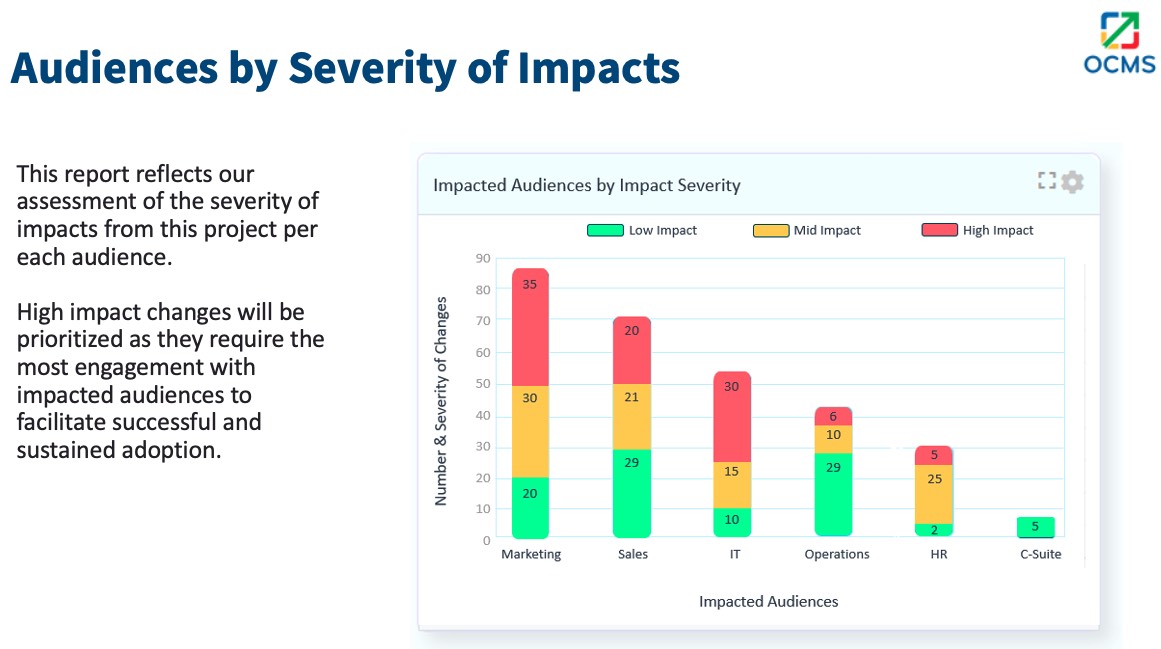
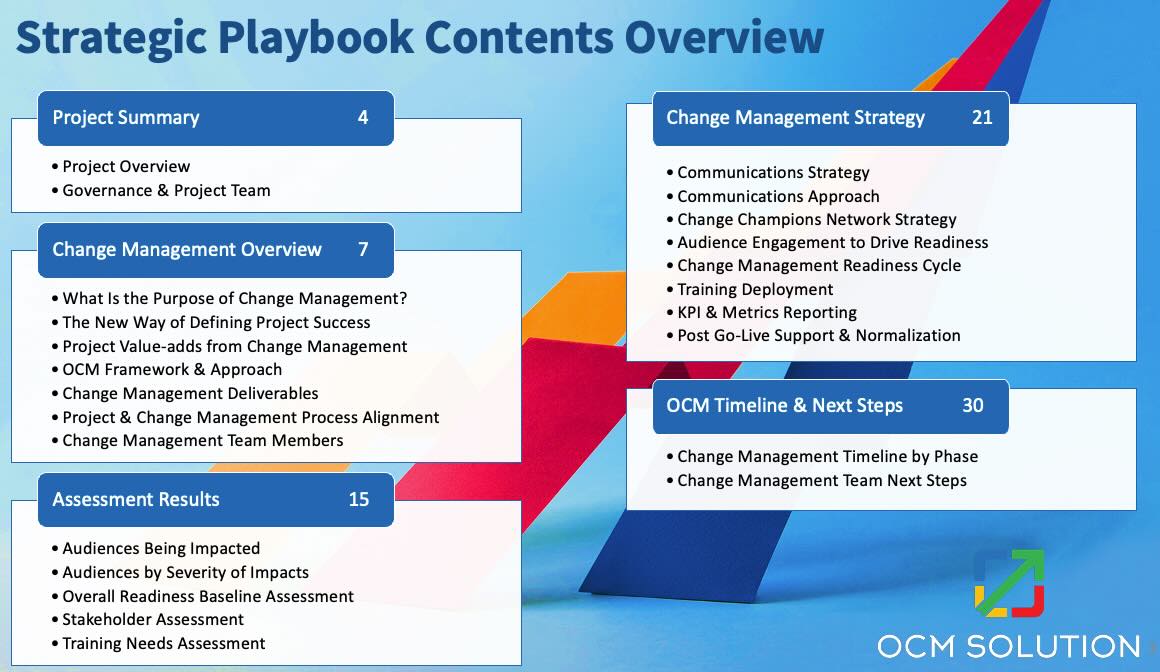
Help others visualize the change impact assessment meaning using the free OCMS Portal presentation template with change impact assessment heat map!
(6.4) Present the change impacts to senior leaders, the steering committee, and other program leaders, and also discuss the next steps. If you have completed a roadmap of your other change management and project management deliverables, then you should also present this to give leaders a preview of what is coming.
(6.5) Based on the findings from your impact assessment exercise, you will then need to develop your training program, as well as your communications and engagement activities. Not every business change will require a training or engagement program. The severity and scale of the business impacts will be a determining factor in the change deliverables that you need to develop to support the business change.
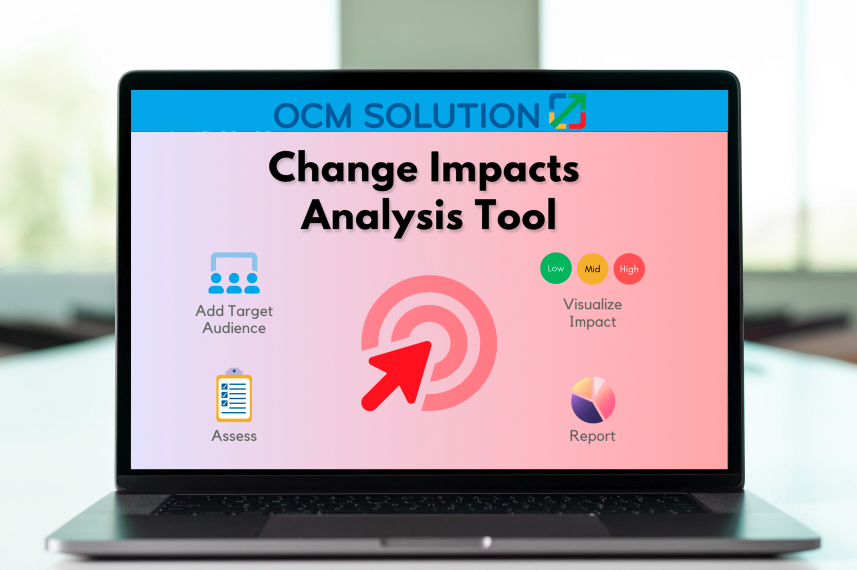
Elevate your team’s change management experience with OCMS Portal. Jump right in with a free trial today.
Step 7 (“Finalize Stage”) of the Impact Assessment Process
Step seven of the change impact framework is the “Finalize” stage. It involves incorporating inputs and finalizing your change management impact analysis.
Now, you are nearing the end of your business impact analysis steps. Take the input you’ve gathered from key project team leaders, managers, and stakeholders, and update your business impact assessment template accordingly.
If using the OCMS Portal change impact analysis template, once you revise the change impact analysis template, your impact assessment report analytics will update automatically to provide insightful perspectives on which groups you will need to engage with the most to facilitate the project.
Do you have any questions or feedback related to this “business impact analyse” and “software impact analysis” article? If so, click here to contact us.
Step 8 (“Monitor & Update Stage”)
Step eight is the “Monitor & Update” stage and involves monitoring for new change impacts & updating the business change analysis.
While many business impact examples you’ll find online for a Deloitte impact assessment definition, Prosci change impact assessment, an impact analysis company, and other models will note the change impact assessment is done at the beginning of your change project, it is always a continuous process.
This means that during the course of your change management, there may be more impact changes happening that you did not anticipate. This could be because certain project parameters may have changed, causing new impacts, then were first illustrated in your initial change impact assessment report.
This is why you need to continue monitoring for any unexpected impact of change on the organization (US spelling) or impact of change on an organisation (UK spelling) throughout the project and for at least 30-60 days after the go-live date.
It’s often after a project goes live that new and unforeseen impacts can arise. Or impacts that were identified when reviewing the current state future state template may be more severe than initially thought.
So, for Step 8, you should continue monitoring the organization for other impacts from the change, and if found, update your business impact analysis template accordingly.
Change Management Impact Assessment Tool, Matrix & Templates
When conducting your end-user impact analysis, it is imperative that you use software, an impact analysis tool, or a change impact assessment template Excel sheet to document the current state, the future state, and what is changing (the delta).
As mentioned above, you can try to develop these impact documentation matrix and tools by yourself. If so, make sure that you include fields to document the severity of the impacts, which groups and job roles are impacted, and how they will be impacted, as well as change management requirements.
The OCMS Portal Change Impact Assessment Tool includes best-in-class change impact assessment database templates, samples, a 360-degree analytics view of impacted groups, and much more that you can leverage to simplify and optimize your change impact performance.
OCMS Portal is a full-featured cloud platform to help you plan, manage, and execute a successful change project, end-to-end, whether this is your first change project or your one-hundredth. You can choose all toolkits in the tool or just choose the Change Impact Assessment Toolkit.
Click below to purchase this tool that will allow you to get started right away.
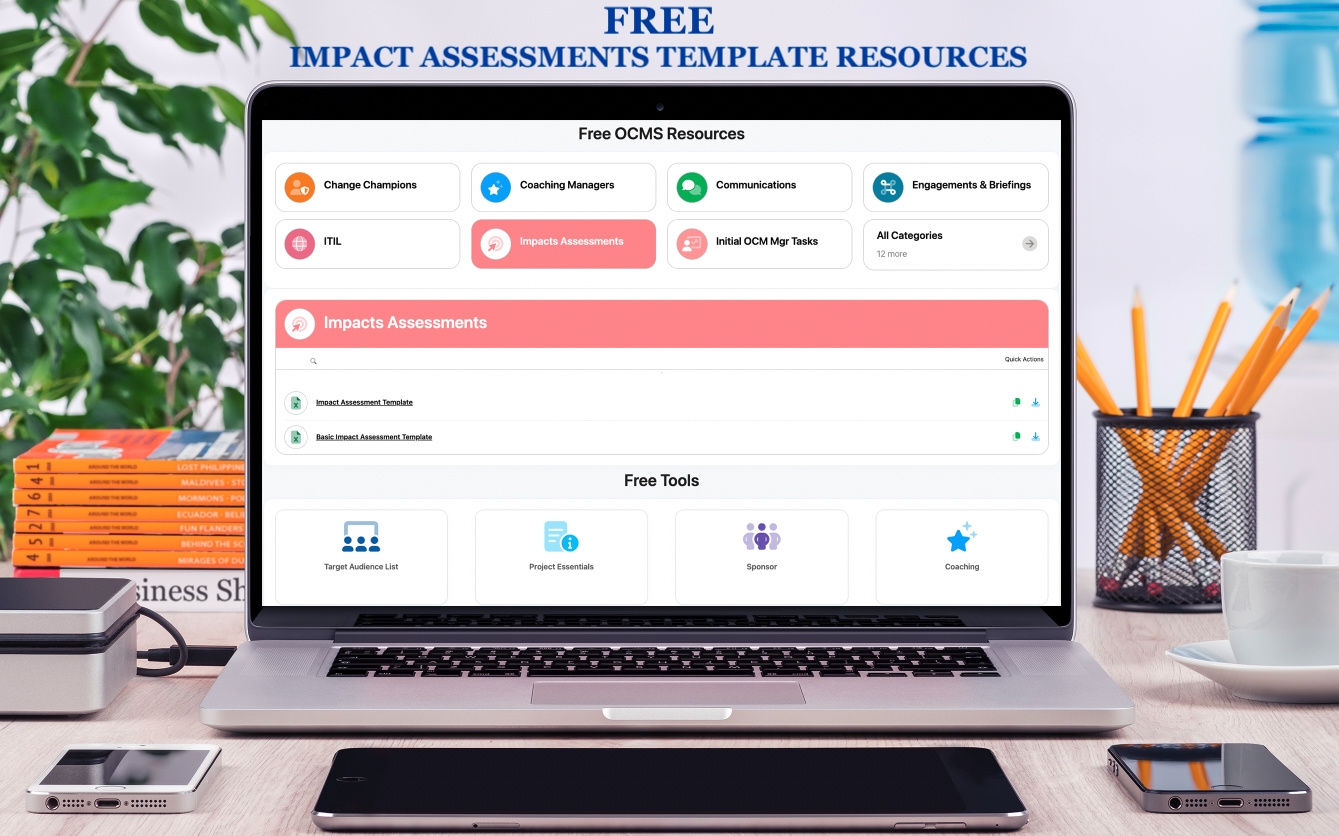
OCMS Portal Business Impact Assessment Tool with Free Resources
Looking for other types of assessments? Click below to check out our other impact assessment guides.
- Privacy Impact Assessment Guide
- Data Protection Impact Assessment (DPIA) Guide
- Economic Impact Analysis Guide
Do you have any questions or feedback related to “as is assessment” or “to be assessment” found in this article? If so, click here to contact us.
How To Do Impact Analysis FAQs
What is impact analysis for a project?
A project impact analysis is a review of the impacts that a project will have on how people do their work or interact with an organization. Projects will often impact internal and external stakeholders in varying degrees, and a project impact assessment example will identify who is being impacted and how severe that impact is.
Why are change impact assessments important?
It’s important to use a project impact assessment template to gauge the impact a project will have on an organization so the move from the current state (As-Is) to the future state (To-Be) can be facilitated using change management. Your business process analysis template will identify the areas of risk for a project if the impacted groups and individuals aren’t properly engaged, communicated with, trained, and coached to successfully adopt the new future state.
What should be included in a change impact assessment?
When gauging the impact of change on an organisation (UK) or organization (US), you want to include certain things that will make up your impact analysis definition. These include:
• Which organizational groups are being impacted
• Which job roles are being impacted
• Which external groups are being impacted
• What level of impact is happening with each impacted entity
• Your plans for the next steps with each of those impacted groups
When do you conduct an organizational impact assessment during a project?
Once the parameters, scope, and timeline for the project are finalized, the change management team will ideally conduct a project impact assessment and begin business impact management activities. They should also continue monitoring for any change impacts that arise during the lifecycle of the project and for at least 30-60 days after the project goes live.
Note: Content on OCM Solution's ocmsolution.com website is protected by copyright. Should you have any questions or comments regarding this OCM Solutions page, please reach out to Ogbe Airiodion (Change Management Lead) or the OCM Solutions Team today. OCM Solution was previously known as Airiodion Global Services (AGS).
External image sources:
- Stock.adobe.com
- https://www.ls.graphics/free/free-pixel-4-and-pixelbook-go-mockup



